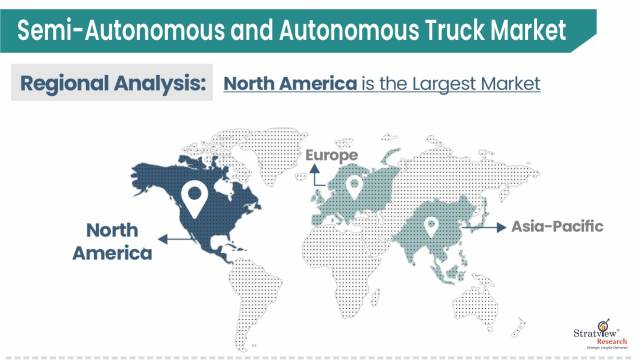Segment Analysis
|
Segmentations
|
List of Sub-Segments
|
Segments with High-Growth Opportunity
|
|
Propulsion Type
|
Diesel, Electric, Hybrid
|
Electric trucks will dominate due to emission norms, while Hybrid trucks will grow fastest as a transitional solution.
|
|
Truck Type
|
Light-Duty, Medium-Duty, Heavy-Duty
|
Heavy-Duty trucks will lead due to long-haul logistics demand, while Medium-Duty trucks will grow fastest for urban deliveries.
|
|
Automation Level
|
Level 1, Level 2, Level 3, Level 4, Level 5
|
Level 4 is expected to dominate due to regulatory approvals, while Level 2 & 3 will grow fastest due to cost-effectiveness.
|
|
Application Analysis
|
Logistics, Mining, Construction, Others
|
Logistics will remain dominant, while Mining will grow fastest due to automation in hazardous environments.
|
|
Region Analysis
|
North America, Europe, Asia-Pacific, RoW
|
North America will lead due to tech adoption, while Asia-Pacific will grow fastest due to expanding e-commerce logistics.
|
By Propulsion Type
"Electric trucks are expected to remain the dominant and fastest-growing propulsion type in the market during the forecast period”.
The market is segmented into diesel, electric, and hybrid propulsion. Electric trucks are expected to remain the dominant and fastest-growing segment during the forecast period, driven by stringent emission regulations, government incentives for zero-emission vehicles, and advancements in battery technology.
The demand for electric trucks is further propelled by the growing focus on sustainability, rising fuel prices, and the expansion of charging infrastructure.
By Truck Type
"Heavy-duty trucks are expected to remain dominant, whereas medium-duty trucks will be the fastest-growing truck type in the market during the forecast period."
The market is segmented into light-duty, medium-duty, and heavy-duty trucks. Heavy-duty trucks are expected to remain dominant due to their extensive use in long-haul logistics and freight transportation. Meanwhile, medium-duty trucks are likely to grow at the fastest rate, driven by increasing demand for urban and regional logistics, last-mile deliveries, and the rise of e-commerce.
North America’s heavy-duty truck fleet is the largest in the world, with major logistics companies investing in autonomous freight solutions to reduce operational costs and improve efficiency. The fastest growth in medium-duty trucks is primarily due to their versatility in urban logistics, lower infrastructure requirements compared to heavy-duty trucks, and increasing adoption by delivery and service fleets.
By Level of Autonomy Type
"Level 4 autonomous trucks are expected to remain dominant, whereas Level 2 & 3 will be the fastest-growing automation levels in the market during the forecast period."
The semi-autonomous & autonomous truck market is segmented into Level 1, Level 2 & 3, Level 4, and Level 5 automation. Level 4 autonomous trucks are expected to remain dominant due to increasing regulatory approvals for limited self-driving operations in freight corridors and growing investments in high-automation freight solutions. Meanwhile, Level 2 & 3 automation is likely to grow at the fastest rate owing to its cost-effectiveness and ability to enhance driver assistance without requiring full autonomy infrastructure.
The dominance of Level 4 autonomous trucks is primarily driven by the rising demand for long-haul freight automation, technological advancements in AI and sensor fusion, and supportive government policies. The fastest growth in Level 2 & 3 automation is attributed to its immediate applicability in existing fleets, lower implementation costs, and gradual transition toward higher automation levels.
By Application Type
"Logistics is expected to remain the largest application segment, whereas mining will be the fastest-growing application in the market during the forecast period."
The market is segmented into logistics, mining, construction, and others. Logistics is expected to remain the largest application segment due to the booming e-commerce industry and the need for efficient freight transportation. Meanwhile, mining is likely to grow at the fastest rate, driven by the increasing adoption of autonomous trucks in hazardous and remote mining operations to enhance safety and productivity.
Regional Insights
"North America is expected to remain the largest market for semi-autonomous & autonomous trucks during the forecast period."
In terms of regions, North America is expected to remain the largest market for semi-autonomous & autonomous trucks during the forecast period. North America’s dominant position is significantly bolstered by several key factors, including early technological adoption, strong regulatory support, the presence of leading autonomous truck manufacturers, and a well-established logistics infrastructure.
In addition, the presence of major fleet operators and logistics companies in the region is expected to fuel the market during the forecast period. Asia-Pacific, mainly driven by rapid urbanization, expanding e-commerce logistics, and government initiatives for smart transportation, is expected to grow at the fastest rate during the forecast period.

Know the high-growth countries in this report. Register Here

